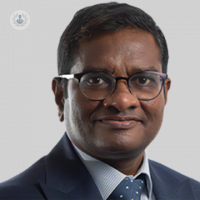How do eye doctors test for glaucoma?
Written by:Glaucoma is the leading cause of irreversible blindness worldwide and is damage to the optic nerve associated with a characteristic visual field defect. It is estimated that 70 million people are affected worldwide, 7 million being blind in both eyes. It is estimated that almost half a million people are affected with glaucoma in the UK, one in 50 in those over 40 years of age and one in 10 in those over 75 years of age.
Here, highly revered consultant ophthalmologic surgeon, Mr Sambath Tiroumal, explains whether the condition is preventable and the different ways that glaucoma is tested for.

Is glaucoma hereditary?
Glaucoma is not hereditary in the sense that a person will not definitely develop glaucoma even if one or both parents have also been diagnosed with the same condition. However, at the same time, it is well documented that a strong risk factor for developing glaucoma is whether a first-degree relative has also been diagnosed with the condition.
A number of research studies have been performed that demonstrate a genetic link, a number of gene locations having been identified in association with glaucoma. While these findings may help us better understand what causes or progresses the disease, the presence of these genes is not predictive of glaucoma.
Genetic screening is therefore not currently indicated but highlights the importance of being aware of whether a close relative has been diagnosed with glaucoma and arranging further assessment.
What causes glaucoma?
Glaucoma is often categorised as primary, when no cause has been found, or secondary when a cause has been identified. Glaucoma can then be subcategorised as open or closed depending on the anatomy of the drainage angle.
Primary open angle glaucoma (POAG) is the most common type of glaucoma and while no cause has been identified, it is associated with a number of risk factors including increasing age, raised eye pressure (intraocular pressure, IOP) and a family history of glaucoma.
Primary angle closure glaucoma (PACG) occurs when the anatomical drainage of the eye is narrow resulting in a build-up of fluid in the eye and associated raised IOP. This may occur gradually or suddenly as an ophthalmic emergency, acute angle closure glaucoma (AACG).
Secondary glaucoma is when a cause has been identified and these include steroid or lens induced, previous trauma, inflammation within the eye (uveitis), pseudoexfoliation (a type of protein deposition that occurs in the eye as well as the rest of the body) and pigment dispersion syndrome. A formal assessment by an ophthalmologist will be able to determine the presence and type of glaucoma.
Can you prevent glaucoma?
Most types of glaucoma cannot be prevented but early detection of the disease and treatment to lower the eye pressure may reduce the risk of disease progression and therefore prevent irreversible sight loss.
How can you test for glaucoma?
An ophthalmologist will perform a number of tests to assess for glaucoma:
Intraocular pressure (IOP)
This is the only risk factor that can be modified to reduce the risk of disease progression. At the optician, they will usually assess this with a non-contact ‘puff of air’ test that is a useful screening tool but not the most accurate assessment of IOP.
Central corneal thickness (Pachymetry)
Most IOP measuring devices are calibrated for a certain level of corneal thickness and if a patient’s cornea is thicker or thinner than average, this may have a bearing on their IOP measurement, especially if performed via a non-contact device that often over-estimate IOP in patients with increased corneal thickness compared to the average population.
Anterior chamber assessment (Gonioscopy)
This will be performed to assess whether the drainage of the eye is open or closed. If the drainage angle is closed, an ophthalmologist will discuss various treatments that may include laser or surgical options.
Fundal Assessment
An ophthalmologist will examine the back of the eye to determine whether there is evidence of damage to the optic nerve due to glaucoma as well as to assess for any other ocular pathology.
Imaging
A range of imaging techniques to assess for optic nerve damage, such as optical coherence tomography (OCT), can be used to assist diagnosis and monitoring of progression of glaucoma.
Visual Field Assessment (Perimetry)
Glaucoma is characterised by loss of visual field and perimetry testing will assist the diagnosis and monitoring of progression of glaucoma.
If you are concerned about developing glaucoma, do not hesitate to book an appointment with Mr Sambath Tiroumal for a check-up by visiting his Top Doctors profile today.


